Ruth Kozak: Life, Love and Work for a 1950s East Van Girl
Historical fiction writer Ruth Kozak (b. 1934) offers a very detailed picture of post-war East Vancouver through the eyes of a hopeful teenage girl.
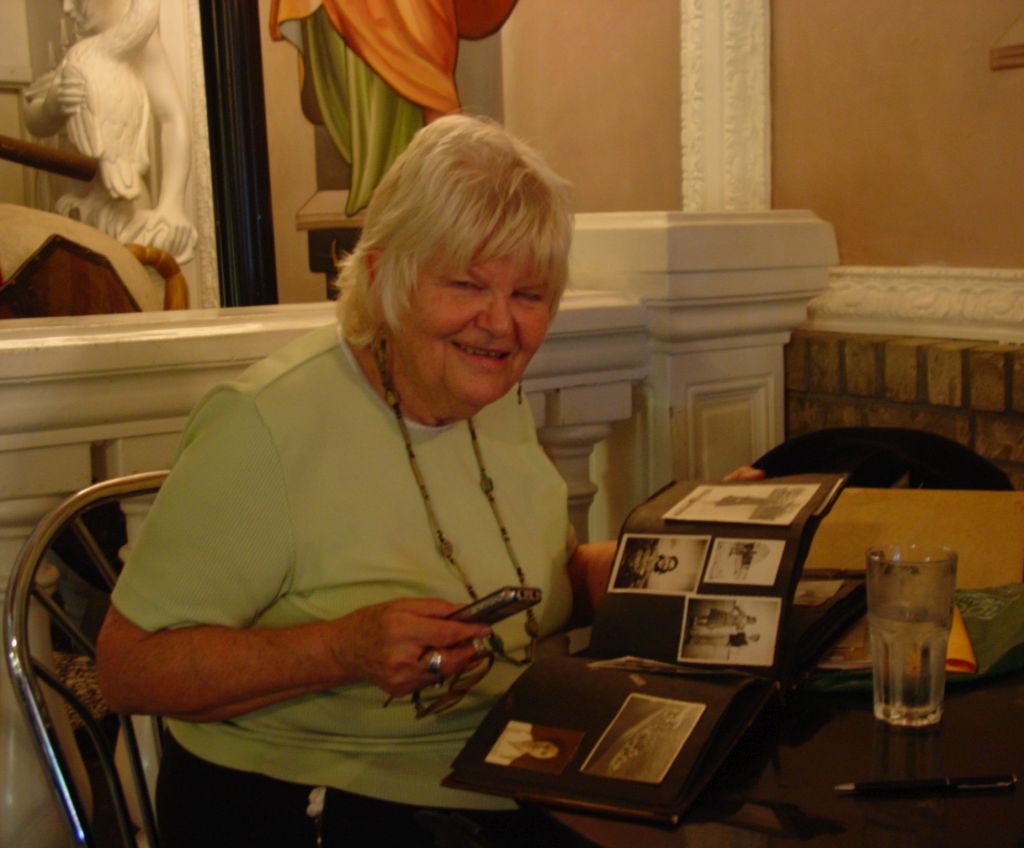
Ruth Kozak is a writer and travel journalist from Vancouver, B.C. Born in Saskatchewan, she first lived in Ontario until her family moved to East Vancouver in 1946 when her father took on the position of Minister at the Grandview-Calvary Baptist Church (Salsbury St.@1st St.). She attended Templeton Junior High and then Britannia High School. Recently, Ruth published the first volume of her life’s work, Shadow of the Lion – a historical novel about Alexander the Great, which she worked on for 15 years.
MY FAMILY LIFE

My family had a very British type of diet. Mom was fantastic cook and a very, very good homemaker in general, and she would make roast beef and potatoes every Sunday. Every Monday was baking day, when she would bake for the entire week: usually, Nanaimo bars, matrimonial cake, or cookies. We bought lots of fruits and veggies, and my parents liked gardening, so we always grew a lot of our own vegetables.
On Friday nights, we liked to go to Nick’s Spaghetti House on Commercial Drive–it’s still there–or sometimes we would eat in Chinatown. The first White Spot opened in the 50’s, and we loved going there for hamburgers–they were the best ever! Another popular hangout was Jolly Joan’s on East Hastings, run by one of my friends’ moms, which was a typical 50’s diner with a jukebox, and all the kids hung out there. Now it’s called the Master Chef Café.
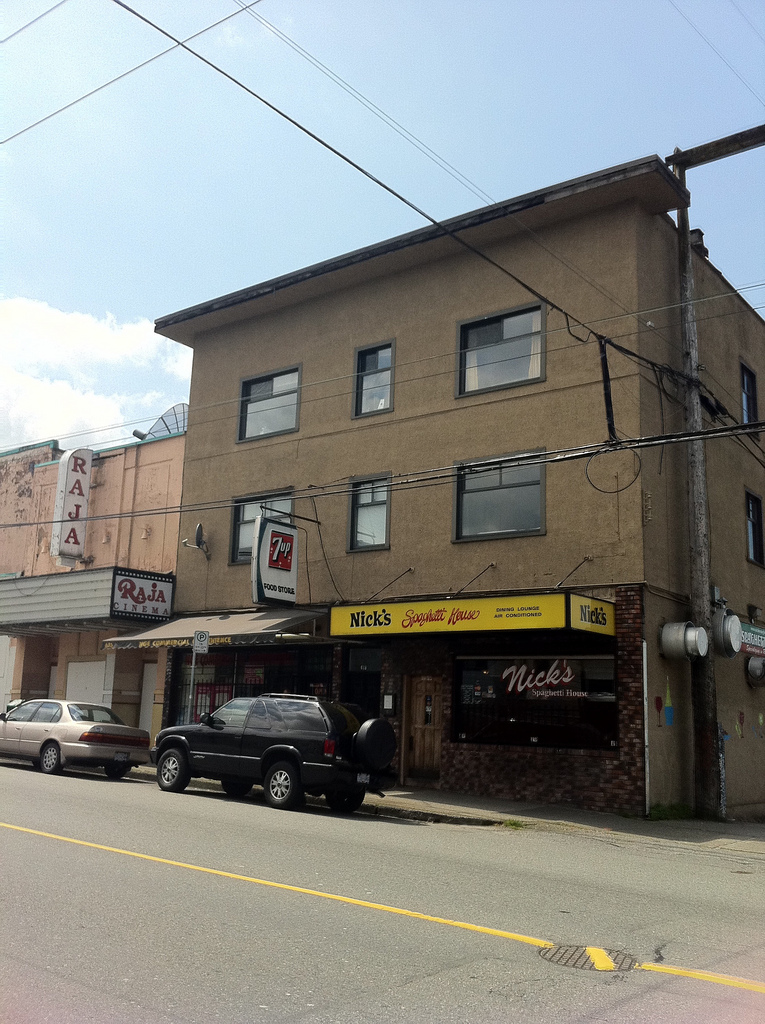
Image credit: Kelly Constabaris, CC, Flickr
Then, in the late 50’s, we started to get Kraft Dinners and sliced cheeses, Shredded Wheat, Rice Krispies, etc. Funny thing, I don’t remember having tasted yogurt until I went to Turkey in 1975; maybe some people did, but my family never had yogurt.
Mom was the driver in our family. My dad didn’t like driving, and he only started after she died. On Sunday afternoons, took Dad out to give him driving lessons, and she would leave me on the side of the ditch. But she made sure I took driving lessons when I grew up.
I was supposed to aspire only to get married, because that was the big deal, to get married and have a family. In those days, most girls got married right out of high school. My Mom and Dad’s generation didn’t believe women really needed to go to university. It didn’t bother me because I only wanted to be a writer, so, when I got a chance to work as a copy runner for The Vancouver Sun at the age of 19, that was a dream come true. When I started working, my mother would take my pay cheque and put some in a savings account for me, and she always made me pay a teeny bit towards the home expenses, as it was the responsible thing to do. I had a strict upbringing, but I also had very loving parents.
My mother died of cancer at only 53 years old. Not long before she died, she wrote me a letter which I still have, and she said “you’re gonna make it one day, dear”. As soon as I got my book accepted by a publisher, after 22 years of hard work, I thought I should go to my mom’s grave and put some flowers on it with a little note to say “I made it!”
My father, on the other hand, was more practical. He died right before turning 90, and the last gesture he did for me was to buy me a computer- his acceptance of my career as a writer. That meant a lot, finally having his blessing for my choices.
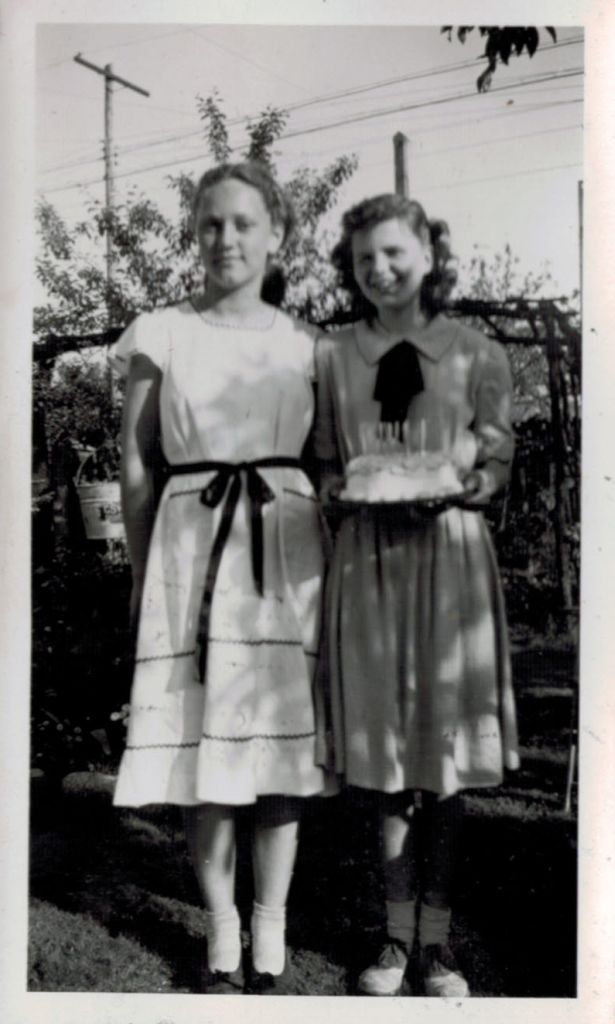
MY NEIGHBOURHOOD
Coming from a small town in Ontario, I had minimal exposure to diversity, so East Van was quite fascinating to me. On Kitchener St., where I lived, there was a clause stating that residents were not allowed to sell houses to Chinese or East Indians, which was legal back then.
The neighbourhood was made up of mostly working-class people, and there were a lot of Italian immigrants at the time. My girlfriends and I were totally entranced by the lovely Italian boys who hung around on the steps of their houses, and we would always stroll by and talk to them. But we weren’t allowed to congregate, because, Heaven forbid, if I got involved with an Italian, he might be a Catholic! That was a big no-no! But I guess that’s just me: I’ve always been more interested in the more exotic kind of boys rather than in the ones who like to watch hockey all the time, and that goes even today!
After this whole summer of stalking these Italian boys, the Labour Day weekend came, and I had been to the PNE with my friends. This Italian boy, Artie–he was a little older than me, maybe 20, and drove a maroon pickup truck–called us over and said he’d drive me home, even though I lived only two blocks away.
He parked in front of my house, and I noticed the porch light flicker a couple of times, but I ignored it, and then I noticed the Venetian blinds open a couple of times but I ignored that as well. We were sitting there in the car, necking–first time in my life I ever did that–and, next thing I know, my mom was out in her housecoat, rapping on the windows: “you get in the house right now!” After that, I was too embarrassed to talk to him again.
Then when I was 17-18, I started noticing all the American sailors who came to town, and they were pretty intriguing as well. I was kinda nerdy at school, always writing, but I met this American cadet–nice fellow–and I invited him to my graduation. So there was the little nerdy Minister’s daughter who never went out with boys, coming to graduation with an American sailor in uniform!
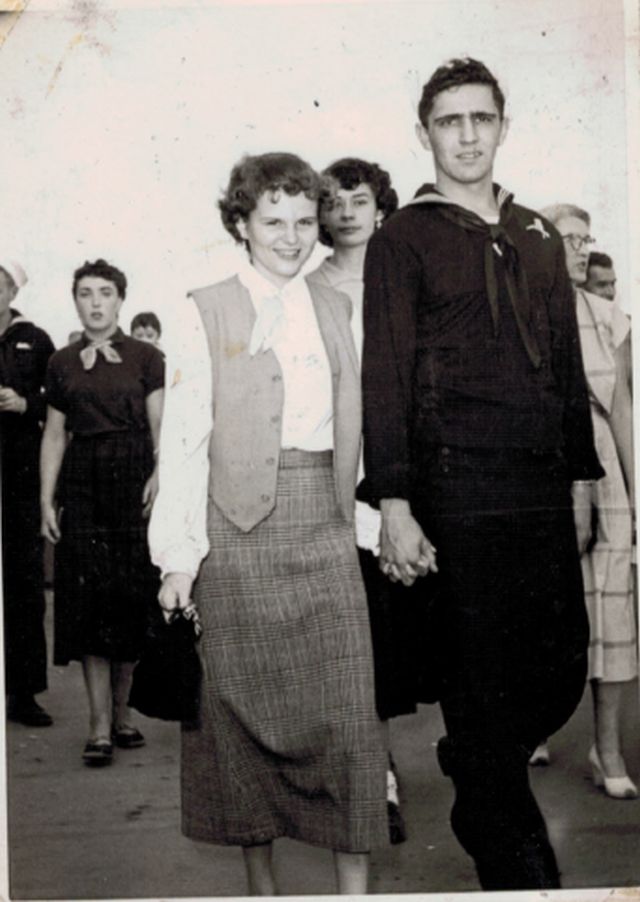
My first experience with a Japanese person was at Templeton, and a little girl I hung around with- Joan Simoto- brought these interesting lunch boxes to school – bento boxes. She brought sushi and I brought sandwiches, so we traded, and, one day, she invited me to her house on Cassiar St. And, you know, it wasn’t until years later, when I read Joy Kogawa‘s Obasan book, that I realized Joan’s family had just come out of internment. I didn’t know anything about what was going on.
There was not much talk about these issues in my daily life. I met one First Nations girl from Alert Bay who came to school here to be a nurse so she could go back to Alert Bay and help her people because her mom had died of tuberculosis. I was fascinated with First Nations cultures as a child; I had this whole romantic idea in my head, and I didn’t know what was really happening to them and how they were being treated.
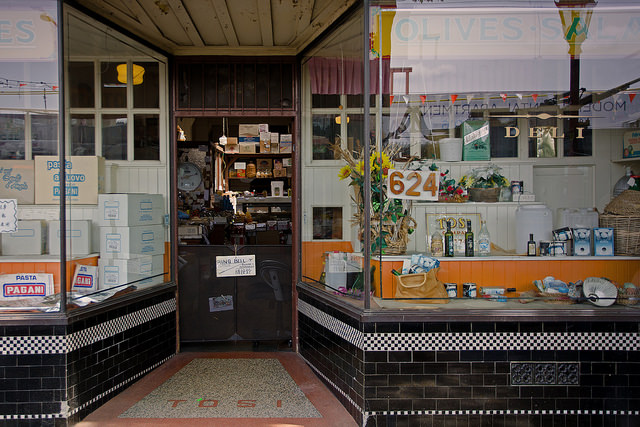
Image credit: roaming-the-planet, CC, Flickr
Angelo Tosi, the owner of the Italian deli on Main Street, went to school with me. I remember I had a pen pal from Sicily, and sometimes he wrote in Italian, so I took his letters to Angelo to translate them. He told me: “you shouldn’t be writing to this man, because he’s not very nice,” and I didn’t understand why. One day, I came home from school, and my father was furious: he had got a call from Immigration because a man in Sicily said he was coming to Canada to marry me! I know Angelo is still running that store; I should pay him a visit and ask if he remembers this.
I recall that there were also lots of Estonian people living on 1st Ave, and my father had a very close communication with them, and even let them use the church for their services.
FASHION
My mother was an expert seamstress, and she would make many of my clothes. She even made my wedding dress and my bridesmaids’ dresses. But what I wanted the most was a tailor-made skirt and a cashmere sweater; I had really nice clothes, but I didn’t have cashmere sweaters.
When I got my first pay cheque, I went to a tailor’s down in Chinatown, got a tailor-made skirt and a cashmere sweater, and wore it with a little dickey collar, because that was the fashion. We also wore the big skirts with the crinoline underneath, and the tartan skirts with only a button and a big pin to hold them, and the long navy blue Burberry raincoats. One night, I was on the bus with my girlfriend Ruth, and the button popped on her tartan skirt, and her skirt fell off, so she just picked it up and folded it over her arm – fortunately, she was wearing a long coat and nobody noticed.
We wore pedal-pusher pants, and the boys wore pants they called “strides”, wide at the knee and narrow at the ankle, with a high waist and butterfly back, and suit coats with shirts and ties. Even my husband always wore shirts that had to be starched and ironed; he dressed very smartly. He also wore fedora hats, and I’ve noticed that they are coming back in style. Girls weren’t allowed to wear slacks to school even in the winter; if you wore them to school because of snow, you had to take them off before class. Even professional women like Simma Holt only wore skirts.
In junior high we started stuffing our bras, because my girlfriend Ruth and I were very tiny and we didn’t have a bust. My mom felt sorry for us and she went to Army & Navy and buy us both these padded bras that she used to call “gay deceivers”.
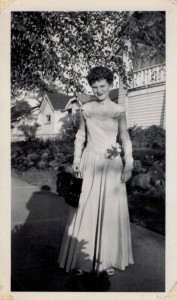
I was in grade 11, and the poodle cut was fashionable: the short curly style. My mom was good at doing home perms with store-bought kits, but at that time, my mom and sister were quarantined because my sister had scarlet fever, and I was staying with an elderly family friend. She knew I desperately wanted a poodle cut, so she gave me some money, and I went to a salon on the Drive where they had these machines like big helmets, which used electricity to curl your hair, but I think they left it too long because, at the end, my hair was huge! I was too embarrassed to go to school, and I couldn’t go home for my mom to fix it, so I had to wear a kerchief on my head. I had a huge crush on a guy who was in the 12th grade, and I recall him coming by, patting me on the hair, and calling me “puppy dog”. I was mortified!
When I was very young, my mom used to do my hair like Shirley Temple, with ringlets. Then I had braids, and later it became fashionable to have Toni Home Perms, so once and awhile my mom would give me a perm. We spent a lot of time on our appearance, but we weren’t into brand name things so much back then. I mean, I guess if you were wealthy you’d know about Chanel, Dior and all that, but the average kid living in East Van was definitely not wealthy; people dressed smart, but not extravagantly.
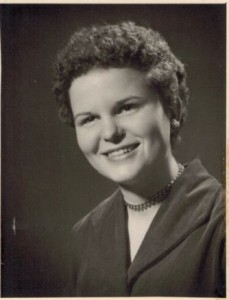
I didn’t wear much make up, because we weren’t allowed to wear make-up to school, but, eventually I did wear lipstick. People used to wear fake tans, and I remember that, one day, a friend of mine, after washing off her fake tan lotion, still had some left on her neck. It looked very embarrassing, and we all noticed, but we didn’t want to hurt her feelings, so I sent her an anonymous note saying ‘Why don’t you remember to wash your neck?” She never mentioned it, but she never had a dirty neck after that.
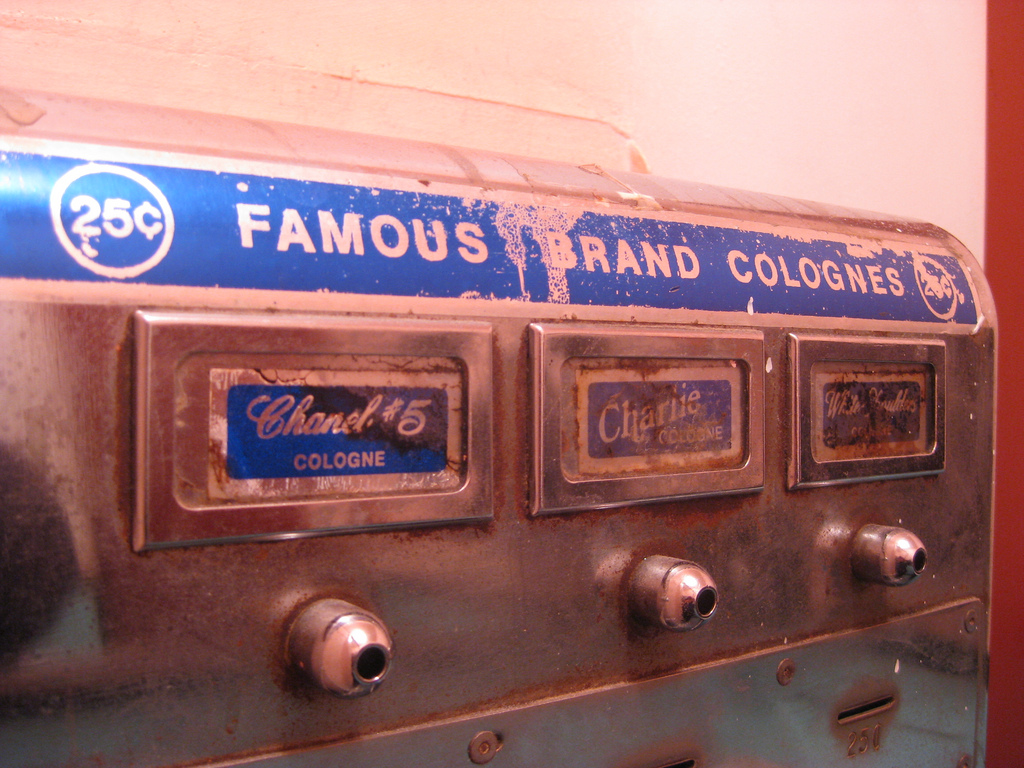
Image credit: Elizabeth Herndon, CC, Flickr
I remember that there was also a very trendy fragrance called Tabu, which was very strong and overpowering. There used to be machines in ladies’ bathrooms where you could insert a quarter and spray yourself with Tabu and other popular perfumes. My mom used to wear nice scents like Lily of the Valley, light fragrances which were pleasant. That was before all this PC stuff, and I can’t remember people complaining about migraines and scent allergies and such. When I first started working in a daycare in the 1970’s, that’s when I started hearing about allergies, but, even then, it wasn’t as big of a deal as it is now.
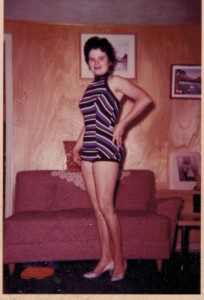
FUN
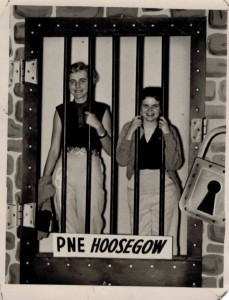
Generally speaking, the 50’s were a lot of fun. I’m still in touch with all my friends from high school and, once a month, we all meet for lunch.
The big deal of the year was to go to the PNE, as it marked the end of the summer right before school started. They had a huge parade, and then we’d all go down to the PNE grounds to see the exhibition where they had these sideshow acts with African-American entertainers in burlesque shows, and we loved going to those because they were a bit racy, and we were teenagers. They had a ride there called the Shoot The Chute, where you would go on boat-type carts and get pulled up to the top, then turn around the corner and land into a big tank of water. I also liked going on the Ferris wheel and merry-go-round.
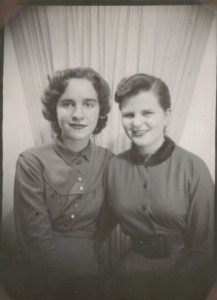
I wasn’t very good at dancing, because I didn’t go to dances until I finished high school. There was a place on Smythe at Haro called Danceland where live bands played, and you had to be at least 18-19 to go in. The police would come sometimes and check our ID, and as I always looked very young, they would pick on me. One time, they checked my wallet and saw a newspaper clipping about the play I’d written, the one about the drugs, and they started questioning how I knew about that stuff. So I would always pull the “but I’m a minister’s daughter” card, and then they would leave me alone. Also, on Davie at Burrard, there was a big dance hall called The Embassy Ballroom (now called Celebrities), and they had big bands playing there.
In my late teens, I worked at The Vancouver Sun in the East End, and there were a lot of Italian bootleggers who made their own wine. If you knew them, you could go to their place, and you could buy a great big bottle of Italian wine for 75 cents. Before going to Danceland, my girlfriends and I went to The Sun newsroom, and there was a big couch in the ladies’ washroom. We would sit in there and have a few glasses of wine, and hide the bottle behind the couch. I think that was the most daring thing we did, drinking Italian bootleg wine.
I had a strict curfew and was supposed to be home before midnight, but, one night, I got home at 1am and my dad was furious. My bedroom was upstairs and I remember my dad whacking the back of my legs with a razor strop as I went up the stairs, but I didn’t dare stop. I felt so sick in the night that I got up and threw up out the window. In the morning, I looked out and saw my dad standing under the window, looking around, and I thought “oh, my God, he’s gonna see where I threw up!” So I went outside and saw it was red, and I thought “oh, no, I must have been throwing up blood”, but now I realize it was from the wine I had drunk. I don’t think he caught on though, or I would have been grounded for God knows how long.
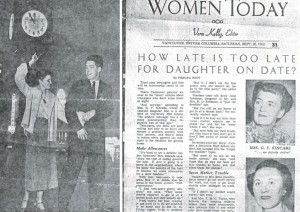
When I got older, there were a couple of clubs where you were allowed to take your own bottle. The Lotus Hotel (Abbott at West Pender) was where the reporters would hang out, but they couldn’t smuggle me into the bar because even when I was 20 I looked like I was 13. Then, in the late 50’s, the Beatnik period started, and I got totally interested in that.
I never developed a smoking habit, because I could never get away with it if my parents smelled it on me. Kids thought it was smart to smoke, and I used to pretend to do it just to be cool. Nobody talked about how bad it was for you.
One of my favourite movie stars was Margaret O’Brien. She was probably around the same age as me, and she was under the strict control of her mother, because she was such a young girl. There was a theatre right near Carnegie Centre– the Pantages Theatre– which was the first vaudeville in Vancouver, which they’ve torn down now. I went there several times in the 50’s to see plays with well-known actors from Hollywood, and one of the plays had Margaret O’Brien in it. So the newspaper editor arranged for me to get a backstage pass, because he wanted me to try to interview her. So, there she was, same age as me, but dressed like a 12 year-old, wearing a sailor top, and surrounded by her mother and her manager, so I never got the chance to talk to her. I just got right up to her and said hello, and that was my big moment of meeting one of my movie idols face to face.
Then, I remember seeing a play with an actor called Bruno Gerussi who went on to become famous as a TV star in this series that they made at Gibsons, The Beachcombers, but I saw him first on stage in a small theatre company in Vancouver, because I used to go to the theatre a lot.

Photo credit: BJ Alias, Creative Commons, Flickr
As for music, I got turned onto jazz in 1953, because I got free passes from the reporters in the newsroom. There was an auditorium where the Bayshore was, where all the famous jazz stars who came to town performed: Chet Baker, Stan Getz, Thelonious Monk, Charlie Parker, Sammy Davis. I fell in love with jazz.
I was also interested in dancing, and I was always restricted and discouraged from dancing, which was strange, because, years later, when my dad was a chaplain at Valley View Hospital, Mom went along (she had cancer at the time), and, one time, she said “you know what I did today? I danced! And your dad was really kind of upset. And you know something? I’ve always wanted to dance.” It was just the way they had been brought up, in an almost Victorian atmosphere, where they thought that dancing might lead to other stuff. I also got intrigued with ballet and flamenco, and, one day, my mom found my ballet shoes in my drawer and she let me practice at home, but in secret.
There was a club called The Cave, and I saw Ike and Tina Turner when they were still together, and Frank Sinatra at the PNE Gardens in late 50’s. There was also a club called Izzy’s, but The Cave was the big one. In the late 50’s, when I first got married, my girlfriends and I were very naughty, and we’d say we were going to the movies but then go to The Penthouse instead. There was gambling in the back, and the guys who were running it, the Filippones, were also running the prostitution business in town. And there was also the Quadra Club where live jazz combos played. It was nice when the Waldorf opened, and they had the Tiki Room- that was such a lovely place and we’d go there with the family all the time.
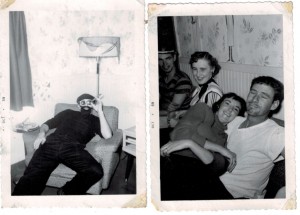
LOVE
My mom always wanted to hook me up with the boys from church, but they were either really boring or really fresh-for some reason, they were much fresher than the ones who didn’t go to church. But I always liked someone who was out of my reach.
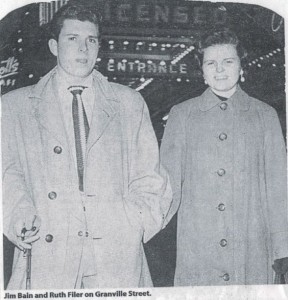
Jimmy was my first serious boyfriend, and I was totally in love with him. He had an old grey Pontiac, and my friends and I would all pile in the car and go riding around, just for fun. He was a nice boy, but he got into this stuff, and he dididn’tnow what it was about. An older guy from Strathcona talked him and his friends into trying this drug none of us knew anything about; it was heroin, and they were hooked within weeks.
A couple of weeks later, when we were at an Italian picnic in Cates Park, he was acting very weird. I knew there was something strange going on, but I didn’t know what. He opened the glove compartment of his car, and showed me a needle, and said “this is what I’m doing now”. Then he said “I’ll quit if you want me to” and I clearly remember saying “oh, it’s ok,” because I was afraid he wouldn’t go out with me anymore.
Jimmy worked for the Burrard shipyards. He always had a job, but my father told me he would rather go to my funeral than to my wedding if I was gonna marry him, because he was an addict. They kept throwing him into Oakalla Prison, because there was no treatment. It was a terrible prison; they even hung people there. So he went to jail a couple of times, and, after jail, he got sent to Port Alberni to make sure he stayed clean. Some years after that, he got married and had a couple of kids.
So I wrote this play called The Street, which was a sort of cautionary tale – mind you, because my parents censored what I wrote and my father was a preacher, I wasn’t supposed to know a lot of stuff, so I had to make it into a redemption story, which it really wasn’t. Somehow, some young people and I got together and produced it and put it on for a couple of nights at a place called The Blue Danube Hall on East Hastings. Years later, in 1998, a theatre producer friend of mine heard about the play and wanted to produce it, when the Five Pillar Program was started in Vancouver. In 2000, they mounted it at the Web Café for a couple of weeks, and it went over really well.
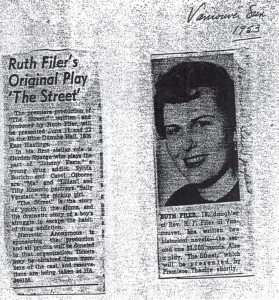
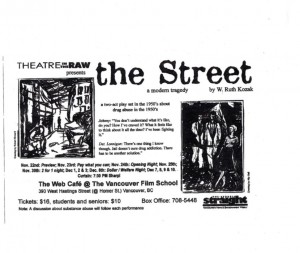
I saw Jimmy a couple of times after my divorce. I was going to a bar in Gastown, where I was hanging out with hippies when all the psychedelic drugs were popular. He was clean then, but I thought it wouldn’t be a good idea to bring him into my crowd because of the drugs. Then I met this other fellow who was a draft dodger or a deserter from the US and I stayed with him.
In 1989, I had this dream about Jimmy, and he was asking me for help. At Christmas, I sent him a card to his sister’s address, and I got a call from him right after the holidays. At the time I had that dream, he had actually relapsed and overdosed. We met up, and he was still as handsome as ever and still working (he had a good union job). He came over to my place and said “I know you need to make some money, and I do too”- basically, he wanted me to run a drug operation from my apartment. So I showed him the door.
Later, in 2000, I found out that he died from a brain aneurysm related to his drug use. The drug dealer from Strathcona who started all this got a life term, but then he was released and ended up back on the streets. I’ve witnessed the drug situation since 1953. They never did anything about it, it was swept under the rug. Now it’s absolutely tragic.
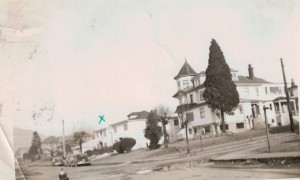
My husband, Mike, was from a Ukrainian family, and he was a lot older than me. I had no concept of this other culture, and especially of the drinking, otherwise I would have recognized early on what the fate was gonna be for my marriage.
In those days, if a girl got pregnant out of wedlock, it was a huge scandal, especially for a family like mine. You had to go to some backdoor place and risk your life, because, if you didn’t, you would bring disgrace upon your family, and they would probably take the baby away from you and you’d never see it again. Mike got me pregnant before we were even engaged, and I was terrified that my parents would find out, so I ended up getting an illegal abortion. He arranged for me to go to an old apartment building on Robson at Cardero to this guy who called himself Doc Wilson, and there was some old lady there, too, and I went in… Girls were dying in those places.
The method that was used, when I look back upon it, was horrifying: there was a long catheter that they shoved up, and told me to keep it in. I couldn’t stay home from work the next day – I was still living with my parents, of course, so I went to work and I got these terrible stomach cramps. I came home and, sometime in the night, I took this thing out and I had the miscarriage, and my mom heard me and got up. I couldn’t get out of bed the next day, and she realized I’d had a miscarriage (I don’t think she realized I’d had an illegal abortion), and all she said was “don’t you tell your dad”. She called a doctor in, and I don’t even know if she told him, but I know of other girls who ended up having to give their babies up. It was very common. Or you’d hear about girls dying.
Once my mom knew of that incident, I knew I was gonna marry Mike whether I wanted or not. It was important for girls to be virgins when they got married.
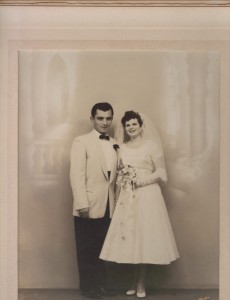
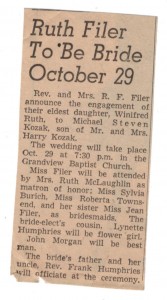
So I got married and I first had my son, and, when I was pregnant with my daughter, she had to have a blood replacement, which was a very traumatic thing to do to a baby. Around that time also, my marriage was not very happy, and, 6 months later, I found out I was pregnant again, because my husband had forced himself on me at an inappropriate time. I was freaked out, as I was not prepared for that, and the doctor told me there was another 50-50 chance that I would have to go through the same thing again, the blood replacement procedure. So I tried to cause myself a miscarriage, and I ended up almost killing myself. My gynecologist was one of the best in town and he caught on to what had happened. I remember he told me after: “if something like this happens to you again, don’t ever do that, you come straight to me”. I knew he would have helped me out, but, at the time it was all illegal, and that’s why I’m very very pro-choice.
SCHOOL
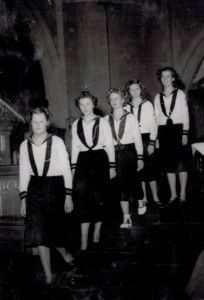
I remember being in the Canadian Girls in Training, in the Girl Guides (the female version of the Boy Scouts) which were very popular for young girls, and, before that, I was in the Brownies, but I can’t remember much of what we did there.
Templeton was a rather rough school; at that time, I think it was the biggest junior high on the West Coast, and because I came from a little school in Stratford, Ontario, Templeton really terrified me. I recall they had lockers with a combination lock on them, and I would always forget mine because I’m very bad with numbers. Sometimes we’d have these thick pea soup fogs in the winter, and we couldn’t see the street names properly, so we couldn’t make it to school on time. They had this monitor who would watch to see if you were late, and, if you were late, you got detention, so I was always scared about being late and not being able to open my locker.
Fights always happened in the school yard. The boys would get somebody and put them up against one of those small trees, and then wrap their legs around it so the kid was trapped – there was always stuff like that going on at Templeton. To me it had the feel of a prison, and some years back, when I went to a school reunion there, I still got that bad vibe from it.
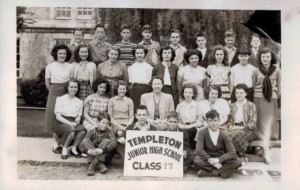
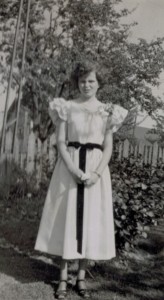
When I went to Britannia, it was different; I loved it and I have nice memories from there. I don’t remember very many teachers, but I do remember my Homeroom teacher, Mrs. Clark, who was a Music and English teacher. All of the boys always played these pranks on her that almost drove her to have a nervous breakdown, but it was quite funny, and they still talk about that. But then, after I graduated and got my first job at the Vancouver Sun, I heard that Mrs. Clark said “well, if she had paid as much attention to her studies as she did to her writing, she would have made a better student.” There was also a German teacher I liked – I think her name was Mrs. Langdale.
I really don’t know how I managed to graduate because, in my last year of high school, all I was doing was I was writing my very first novel on an Alexander the Great theme, and I used to entertain the kids in the study halls by reading them chapters; some of them still remember that.
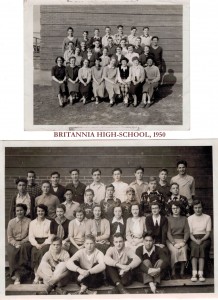
One of my Homeroom teachers in grade 11, Miss Mays, looked like one of those cartoon teachers that you see in the Archie Comics, with her hair drawn back in a bun and glasses – she probably wasn’t that old, you know – and she was very sharp-tongued. We were all kind of scared of her, but, one day, I was on the bus and I saw her sitting there, and when I looked down and she was reading Latin books, like, in Latin. I was so impressed by that, and I realized that this woman was really brilliant, and, much later, when we started to have our reunions, I think she was still around, but she was in a care home, because we all asked “where’s Miss Mays?” Nobody ever forgot her. Then, there was a PE teacher, Betty-something, who was very sweet, only in her early 20’s, because she came to some of our reunions and she wasn’t that much older than us. But I didn’t have a teacher who was a mentor to me, and as far as my writing was concerned, they all thought I should be spending more time on Math and Science, unlike now, when they have all these literature programs for kids. Once, I applied to work on the school yearbook, I actually wanted to write about the kids, but they gave me the task of designing and block printing – and I wasn’t interested in that!
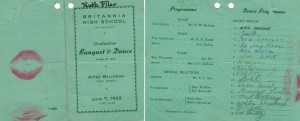
So I was often in my own little world, doing my thing, and I never learned to add or subtract properly. I dropped Math and Science into Grade 10, because I wasn’t interested in it, and there was no one there to make me interested. I was part of the school drama club, and I used to sing quite a bit at church. My girlfriends and I had a trio, and I wanted to become a jazz singer, but I didn’t get a chance. When I signed up to be in operettas, I would just be in the chorus; I never got a starring role, because I guess I was a little too timid. I did try out for an Alice in Wonderland production at the Orpheum Theatre and got in the chorus. Being backstage was so exciting!
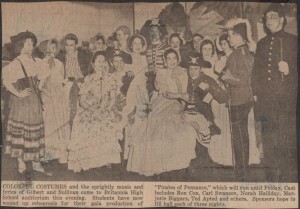
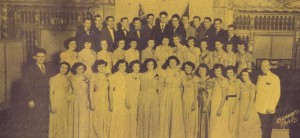
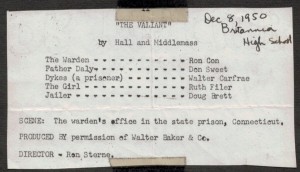
There was a Science teacher who was a handsome guy, but I’m pretty sure he was drinking under the table. We sensed something was going on, but we were too innocent to understand. And there was this French-Canadian girl who had really big breasts, and she’d always sit at the very front of the class, and, naïve as we were, we still realized she was flirting with the teacher. It was one of these things we didn’t talk about, but everybody knew something was going on.
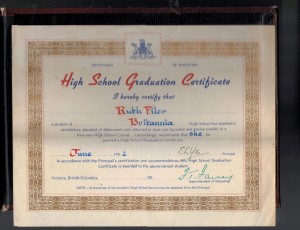
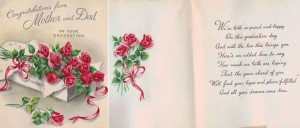
WORK
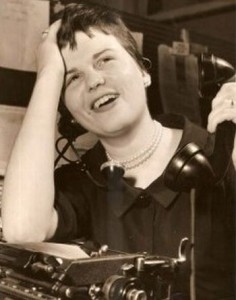
“When I finished high-school, I found a job as a copy runner (intern) in the Vancouver Sun newsroom. I worked with big names like Simma Holt and Jack Webster. Simma Holt wanted to train me for her desk job, but the city editor thought women shouldn’t be at the news desk. He thought ladies should be writing society columns and the sort, so he kept sending me to cover tea parties and library board meetings. Simma was quite an exception for those days – she handled all the stories about the Doukhobors in the Interior, when they were setting fires and having nude parades. I had no interest in society stories, as I wanted to be a crime reporter, so in the end, they put me in charge of the crime and biography files in the news library, and I also modeled for them.
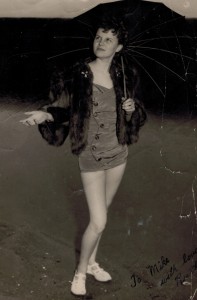
The night of my wedding, we stayed at this hotel on Kingsway at Nanaimo, and then went down to Portland for our honeymoon. When I wanted to go away, they wouldn’t let me have time off work at The Sun, and I said “I’m quitting.” I didn’t want to quit, but I had no choice. When I got back, I worked other jobs I didn’t like very much- boring office-type jobs.
I went back to The Sun to get my job back, but the personnel department said “sorry, we don’t hire married women.” Later, as The Sun was moving from the old Sun Tower into an office on South Granville, I was hired as a temp worker. The The Province and The Sun were combining their news libraries, so I got hired to help compiling the files.
It was a very macho environment, because I remember a young gal who was working as a copy runner and who was quite heavy-busted, and the men were always making rude remarks to her about her boobs, really sexist things, and she’d get quite embarrassed. I remember that kind of stuff very distinctly. With me, it was different, because I was this little girl that they took under their wing. They all took an interest in the fact that I was writing, which was nice.
POLITICS
My friends and I weren’t interested in politics until the Korean War. My girlfriend Ruth had an American boyfriend, Billy, who was a pin boy at a bowling alley at Nanaimo at Hastings, and later on she married him against her parents’ wishes. He was only about 19, married super young, and he went into the army to Korea, so we would hear things from him. Before he went, he was stationed somewhere close to the border, and he came over a few times with his friends. One New Year’s Eve, he brought one of his army friends over, and the four of us all went out. We went to The Cave, and then to the Holy Rosary Cathedral cathedral for mass. We had just come from the night club, and Ruth had a bottle of booze with her- I think she almost dropped it in the church!
My father was the one who knew all the politics, and, as I grew older, I always relied on his good judgment because he knew what was going on. He always spoke about his friend Tommy Douglas, and I didn’t realize until some years later, when Shirley Douglas came here and they made a documentary about her father. It turned out he had been a Baptist minister in South Saskatchewan, like my dad, and they were both sent to work in the mine hills where there was mining trouble, because my dad was miner from Wales and knew about that life. My dad was always a Socialist, and I think even back in Wales, when he was very young, he was in the Welsh Communist Party because he always fought for the rights of the miners. That’s how he lost his job, because he wouldn’t speak against his fellow miners, and they tore up his mining card. Without work in Wales, he had to immigrate to Canada.
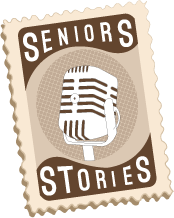
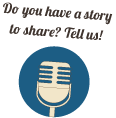
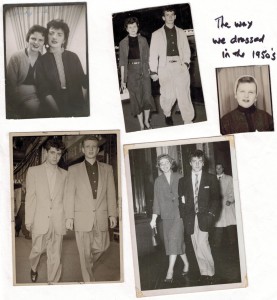
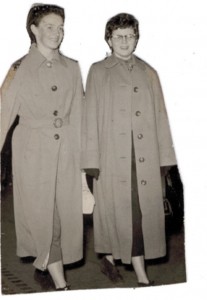
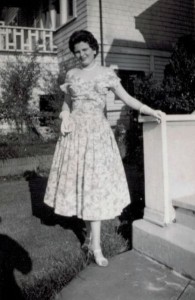


Leave a Reply